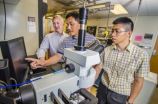(Press-News.org) PORTLAND, Ore. — Researchers with Oregon Health & Science University's Vollum Institute have given science a new and unprecedented 3-D view of one of the most important receptors in the brain — a receptor that allows us to learn and remember, and whose dysfunction is involved in a wide range of neurological diseases and conditions, including Alzheimer's, Parkinson's, schizophrenia and depression.
The unprecedented view provided by the OHSU research, published online June 22 in the journal Nature, gives scientists new insight into how the receptor — called the NMDA receptor — is structured. And importantly, the new detailed view gives vital clues to developing drugs to combat the neurological diseases and conditions.
"This is the most exciting moment of my career," said Eric Gouaux, a senior scientist at the Vollum Institute and a Howard Hughes Medical Institute investigator. "The NMDA receptor is one of the most essential, and still sometimes mysterious, receptors in our brain. Now, with this work, we can see it in fascinating detail."
Receptors facilitate chemical and electrical signals between neurons in the brain, allowing those neurons to communicate with each other. The NMDA (N-methyl-D-aspartate) receptor is one of the most important brain receptors, as it facilitates neuron communication that is the foundation of memory, learning and thought. Malfunction of the NMDA receptor occurs when it is increasingly or decreasingly active and is associated with a wide range of neurological disorders and diseases. Alzheimer's disease, Parkinson's disease, depression, schizophrenia and epilepsy are, in many instances, linked to problems with NMDA activity.
Scientists across the world study the NMDA receptor; some of the most notable discoveries about the receptor during the past three decades have been made by OHSU Vollum scientists.
The NMDA receptor makeup includes receptor "subunits" — all of which have distinct properties and act in distinct ways in the brain, sometimes causing neurological problems. Prior to Gouaux's study, scientists had only a limited view of how those subtypes were arranged in the NMDA receptor complex and how they interacted to carry out specific functions within the brain and central nervous system.
Gouaux's team of scientists – Chia-Hsueh Lee, Wei Lu, Jennifer Michel, April Goehring, Juan Du and Xianqiang Song – created a 3-D model of the NMDA receptor through a process called X-ray crystallography. This process throws x-ray beams at crystals of the receptor; a computer calibrates the makeup of the structure based on how those x-ray beams bounce off the crystals. The resulting 3-D model of the receptor, which looks something like a bouquet of flowers, shows where the receptor subunits are located, and gives unprecedented insight into their actions.
"This new detailed view will be invaluable as we try to develop drugs that might work on specific subunits and therefore help fight or cure some of these neurological diseases and conditions," Gouaux said. "Seeing the structure in more detail can unlock some of its secrets — and may help a lot of people."
INFORMATION:
The research was funded by a gift from Bernard and Jennifer Lacroute, along with a grant from the National Institutes of Health (#R37NS038631) and support from the Vollum Institute. Chia-Hsueh Lee is supported by an OHSU Brain Institute Fellowship, funded by Ronni Lacroute.
ABOUT THE OHSU VOLLUM INSTITUTE
The Vollum Institute is a privately endowed research institute at OHSU and is dedicated to basic research that will lead to new treatments for neurological and psychiatric diseases. Vollum scientists have transformed the field of neuroscience and, in particular, have been pioneers in the study of cellular signaling, neuronal development, gene regulation and the neurobiology of disease.
ABOUT OHSU
Oregon Health & Science University is a nationally prominent research university and Oregon's only public academic health center. It serves patients throughout the region with a Level 1 trauma center and nationally recognized Doernbecher Children's Hospital. OHSU operates dental, medical, nursing and pharmacy schools that rank high both in research funding and in meeting the university's social mission. OHSU's Knight Cancer Institute helped pioneer personalized medicine through a discovery that identified how to shut down cells that enable cancer to grow without harming healthy ones. OHSU Brain Institute scientists are nationally recognized for discoveries that have led to a better understanding of Alzheimer's disease and new treatments for Parkinson's disease, multiple sclerosis and stroke. OHSU's Casey Eye Institute is a global leader in ophthalmic imaging, and in clinical trials related to eye disease.
Research gives unprecedented 3-D view of important brain receptor
New details on the NMDA receptor could aid development of drugs for Alzheimer's, Parkinson's, depression, other neurological disorders
2014-06-27
ELSE PRESS RELEASES FROM THIS DATE:
Study: To address climate change, nothing substitutes for reducing CO2 emissions
2014-06-27
The politically expedient way to mitigate climate change is essentially no way at all, according to a comprehensive new study by University of Chicago climatologist Raymond Pierrehumbert.
Among the climate pollutants humans put into the atmosphere in significant quantities, the effects of carbon dioxide (CO2) are the longest-lived, with effects on climate that extend thousands of years after emissions cease. But finding the political consensus to act on reducing CO2 emissions has been nearly impossible. So there has been a movement to make up for that inaction by reducing ...
Some aggressive cancers may respond to anti-inflammatory drugs
2014-06-27
New research raises the prospect that some cancer patients with aggressive tumors may benefit from a class of anti-inflammatory drugs used to treat rheumatoid arthritis.
Studying triple-negative breast cancer, researchers at Washington University School of Medicine in St. Louis found that some aggressive tumors rely on an antiviral pathway that appears to drive inflammation, widely recognized for roles in cancer, rheumatoid arthritis and other inflammatory diseases.
The tumors that activate this particular antiviral pathway always have dysfunctional forms of the proteins ...
Diamond plates create nanostructures through pressure, not chemistry
2014-06-27
ALBUQUERQUE, N.M. — You wouldn't think that mechanical force — the simple kind used to eject unruly patrons from bars, shoe a horse or emboss the raised numerals on credit cards — could process nanoparticles more subtly than the most advanced chemistry.
Yet, in a current paper in Nature Communications, Sandia National Laboratories researcher Hongyou Fan and colleagues appear to have achieved a start toward that end.
Their newly patented and original method uses simple pressure — a kind of high-tech embossing — to produce finer and cleaner results in forming silver ...
Research may yield new ways to treat antibiotic-resistant TB
2014-06-27
CORVALLIS, Ore. – Scientists in the United States and India have successfully modified the precursor to one of the drugs used to treat tuberculosis, an important first step toward new drugs that can transcend antibiotic resistance issues that experts consider a serious threat to global health.
The findings, reported in the Journal of Biological Chemistry, indicate that a new compound, 24-desmethylrifampicin, has much better antibacterial activity than rifampicin against multi-drug-resistant strains of the bacteria that cause tuberculosis.
Rifampicin and related drugs ...
Youth regularly receive pro-marijuana tweets
2014-06-27
AUDIO:
Twitter has become one of the most popular social media sites among young people, and researchers at Washington University School of Medicine in St. Louis have been looking at Twitter....
Click here for more information.
Hundreds of thousands of American youth are following marijuana-related Twitter accounts and getting pro-pot messages several times each day, researchers at Washington University School of Medicine in St. Louis have found.
The tweets are cause for ...
A new species of moth from the Appalachian Mountains named to honor the Cherokee Nation
2014-06-27
A small, drab and highly inconspicuous moth has been flitting nameless about its special niche among the middle elevations of one of the world's oldest mountain ranges, the southern Appalachian Mountains in North America. A team of American scientists has now identified this new to science species as Cherokeea attakullakulla and described it in a special issue of the open access journal ZooKeys.
In all probability, it has been frequenting these haunts for tens of millions of years before the first humans set foot on this continent, all the while not caring in the least ...
Kids who know unhealthy food logos more likely to be overweight
2014-06-27
The more a child is familiar with logos and other images from fast-food restaurants, sodas and not-so-healthy snack food brands, the more likely the child is to be overweight or obese.
And, unfortunately, studies have shown that people who are overweight at a young age, tend to stay that way.
A research team that included a Michigan State University professor tested kids on their knowledge of various brands – including their ability to identify items such as golden arches, silly rabbits and a king's crown – and found that those who could identify them the most tended ...
'Compressive sensing' provides new approach to measuring a quantum system
2014-06-27
In quantum physics, momentum and position are an example of conjugate variables. This means they are connected by Heisenberg's Uncertainty Principle, which says that both quantities cannot be simultaneously measured precisely. Recently, researchers have been developing novel techniques, such as "weak measurement," to measure both at the same time. Now University of Rochester physicists have shown that a technique called compressive sensing also offers a way to measure both variables at the same time, without violating the Uncertainty Principle.
In a paper published in ...
Developmental psychologist explains her life's work studying the mysteries of the mind
2014-06-27
HAMILTON, ON, June 27, 2014—Developmental psychologist Daphne Maurer has spent more than four decades studying the complexities of the human mind.
As the director of the Visual Development Lab at McMaster University and president of the International Society on Infant Studies, Maurer will present her life's work at the Biennial International Conference on Infant Studies in Berlin July 4th.
Over the course of her career she has established a reputation for building new understanding of one of the most challenging and mysterious aspects of human development: how our ...
Monkeys also believe in winning streaks, study shows
2014-06-27
Humans have a well-documented tendency to see winning and losing streaks in situations that, in fact, are random. But scientists disagree about whether the "hot-hand bias" is a cultural artifact picked up in childhood or a predisposition deeply ingrained in the structure of our cognitive architecture.
Now in the first study in non-human primates of this systematic error in decision making, researchers find that monkeys also share our unfounded belief in winning and losing streaks. The results suggests that the penchant to see patterns that actually don't exist may be ...
LAST 30 PRESS RELEASES:
For teens, any cannabis use may have impact on emotional health, academic performance
School meals could unlock major gains for human and planetary health
Menopause hormone therapy does not appear to impact dementia risk
Signature patterns of brain activity may help predict recovery from traumatic brain injury
Dresden study uncovers new key mechanism in cancer cells
New species are now being discovered faster than ever before, study suggests
Cannabis-based products show limited short-term benefit for chronic pain, with increased risk of adverse effects
Cannabis products with more THC slightly reduce pain but cause more side effects
Clearing the brain of aging cells could aid epilepsy and reduce seizures
Brain injuries linked with potential risk of suicide, new study finds
New technique lights up where drugs go in the body, cell by cell
New study finds movement of fishing fleets can reveal shifts in marine ecosystems
Embargoed: New evidence points to potential treatment for vascular dementia
Study uncovers disrupted brain balance in alcohol dependence
Working in groups can help Republicans and Democrats agree on controversial content moderation online
Structural findings reveal how distinct GPCR ligands create different levels of activation
Anything-goes “anyons” may be at the root of surprising quantum experiments
UC review: Maximizing workplace opportunity for veterans
From generation to complex control: Metasurfaces make perfect vortex beams "within reach"
Thin-film lithium niobate-based detector: recent advances and perspectives
Exploring why some people may tend to persistently make bad choices
How cells balance their protein levels
Nirsevimab vs RSVpreF vaccine for RSV–related hospitalization in newborns
Effectiveness and impact of maternal RSV immunization and nirsevimab on medically attended RSV in US children
AI gives scientists a boost, but at the cost of too many mediocre papers
Next-generation vision model maps tree growth at sub-meter precision
Genes aren’t destiny for inherited blindness, study shows
MIT study: High-fat diets make liver cells more likely to become cancerous
Exposure to multiple fine particulate matter components and incident depression in the US Medicare population
Risk of burdensome health care spending over time in the US
[Press-News.org] Research gives unprecedented 3-D view of important brain receptorNew details on the NMDA receptor could aid development of drugs for Alzheimer's, Parkinson's, depression, other neurological disorders






